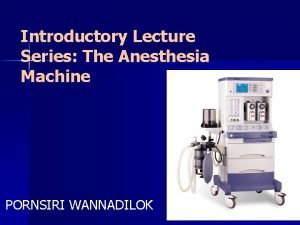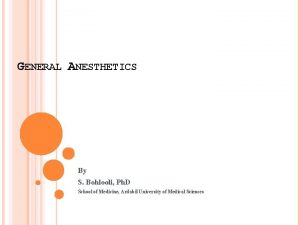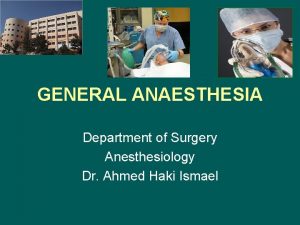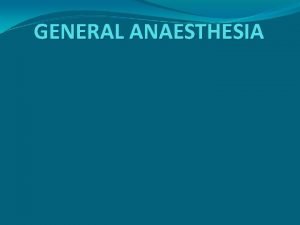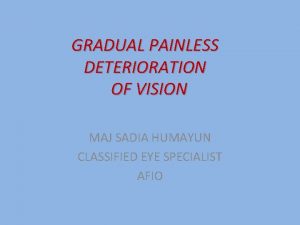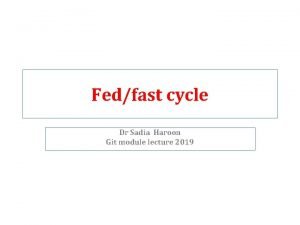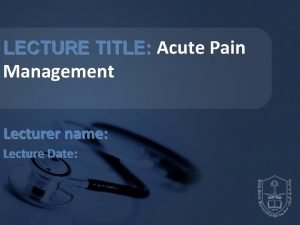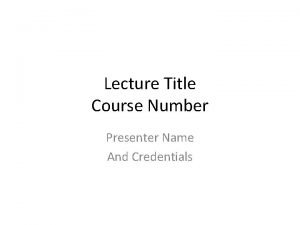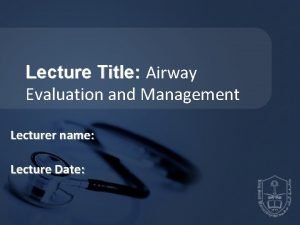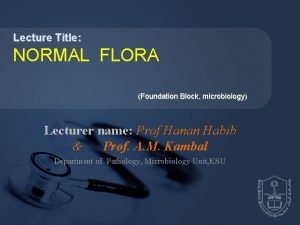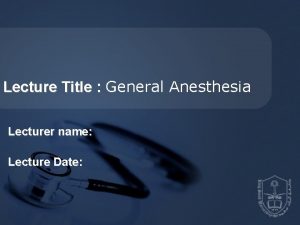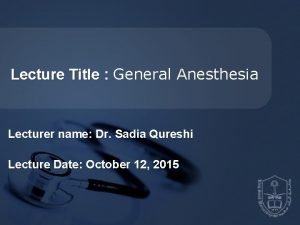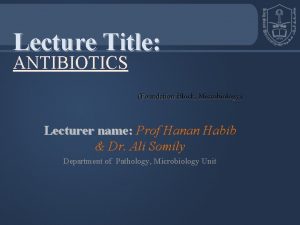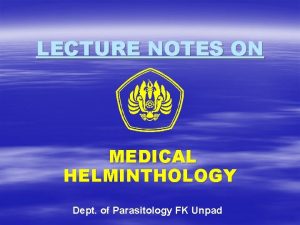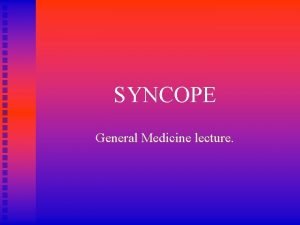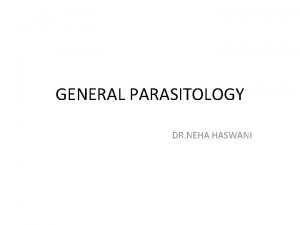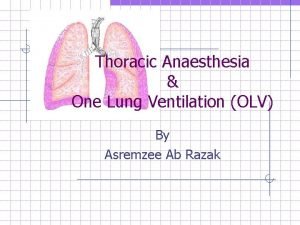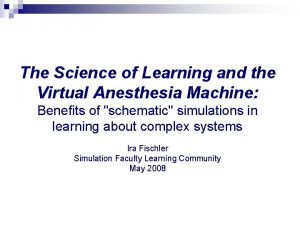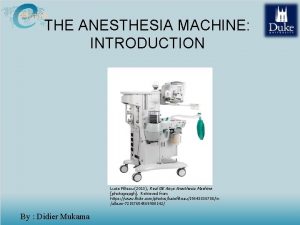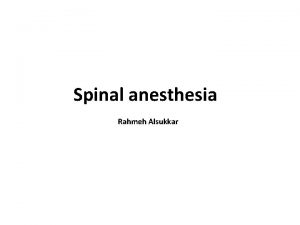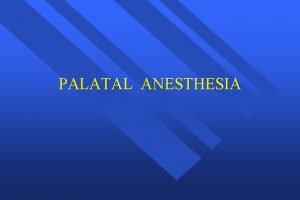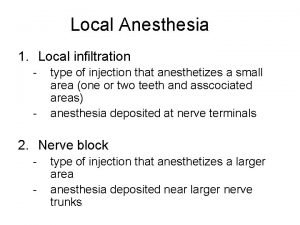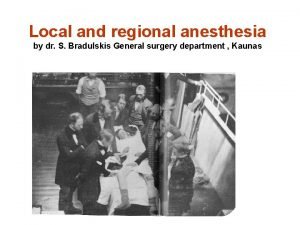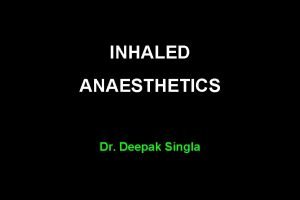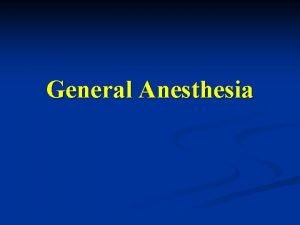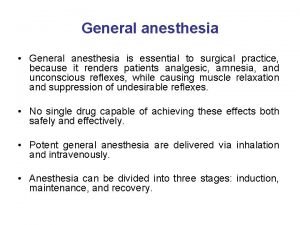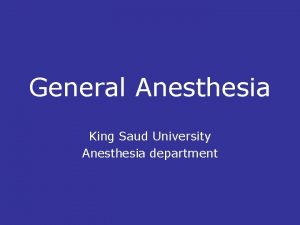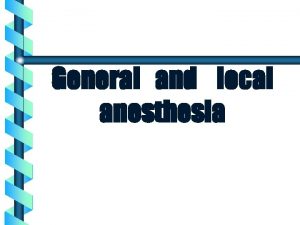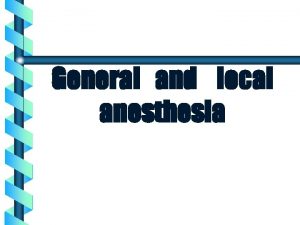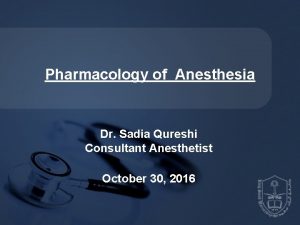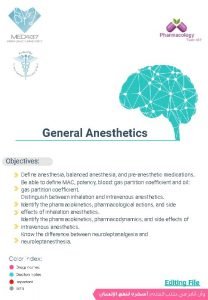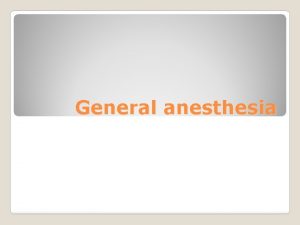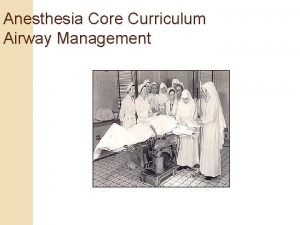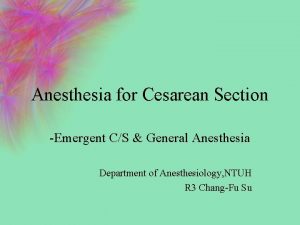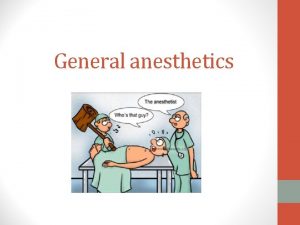Lecture Title General Anesthesia Lecturer name Dr Sadia
























































- Slides: 56

Lecture Title : General Anesthesia Lecturer name: Dr. Sadia Qureshi Lecture Date: October 12, 2015

Lecture Objectives. . Students at the end of the lecture will be able to: 1. Define general Anesthesia 2. Learn about several agents used for induction of general anesthesia including intravenous agents, inhalation agents, neuromuscular blocking agents and reversal agents. 3. Understand basic advantages and disadvantages of these agents. 4. Complications commonly encountered during general anesthesia

Role of Anesthetists • Preoperative evaluation and patient preparation • Intraoperative management - General anesthesia Inhalation anesthesia Total IV anesthesia - Regional anesthesia & pain management Spinal, epidural & caudal blocks Peripheral never blocks Pain management (acute and chronic pain) • Post anesthesia care (PACU management) • Anesthesia complication & management

General anesthetics have been used since 1846 when Morton demonstrated the first anesthetic (using ether) in Boston, USA. Local anesthetics arrived later, the first being scientifically described in 1884.

General anesthesia is described as a reversible state of unconsciousness with inability to respond to a standardized surgical stimulus. In modern anesthetic practice, this involves the triad of: unconsciousness, analgesia, muscle relaxation.

• The primary goal is the maintenance of physiologic homeostasis. This includes monitoring and treatment of cardiovascular, pulmonary, neurological and renal functions and changes during perioperative period to minimize adverse outcomes. Optimizing intraoperative physiology may help speed recovery & perioperative organ system protection.

Objectives of Anesthesia • • • Unconsciousness Amnesia Analgesia Oxygenation Ventilation Hemostasis Airway Management Reflex Management Muscle Relaxation Monitoring

General Anesthesia • • • Assessment Planning I: Monitors Planning II: Drugs Planning III: Fluids Planning IV: Airway Management • • Induction Maintenance Emergence Postoperative care

Preoperative anesthetic evaluation Risks of Anesthesia

Physical status classification • Class I: A normal healthy patient. • Class II: A patient with mild systemic disease (no functional limitation) • Class III: A patient with severe systemic disease (some functional limitation) • Class IV: A patient with severe systemic disease that is a constant threat to life (functionality incapacitated) • Class V: A moribund patient who is not expected to survive with or without the operation. • Class VI: A brain-dead patient whose organs are being removed for donor purposes • Class E: Emergent procedure

Airway examination Mallampati classification Class I: uvula, faucial pillars, soft and hard palate visible Class II: faucial pillars, soft and hard palate visible Class III: soft and hard palate visible Class IV: hard palate visible

NPO status • • • NPO, Nil Per Os, means nothing by mouth Solid food: 8 hrs before induction Liquid: 4 hrs before induction Clear water: 2 hrs before induction Pediatrics: stop breast milk feeding 4 hrs before induction

Premed Anesthetic plan Intraop. management General Airway Management Induction Maintenance Muscle relaxation Postop. management Monitoring Positioning Fluid management Special techniques Pain control PONV Complications postop. ventilation Hemodynamic mont.

General Anesthesia 1. 2. 3. 4. 5. 6. 7. 8. Monitor Pre-oxygenation Induction ( including RSI & cricoid pressure) Mask ventilation Muscle relaxants Intubation & ETT position confirmation Maintenance Emergence

Sniffing position

Mask and airway tools

Oral and nasal airway

Mask ventilation and intubation

Difficult BMV- MOANS • MASK SEAL: mask seal requires normal anatomy, absence of facial hair, lack of interfering substances like vomitus or bleeding & ability of apply mask with pressure. • OBSTRUCTION/ OBESITY: Obstruction of upper airway, obesity (BMI greater than 26) is an independent marker. Redundant upper airway tissue, chest wall weight & resistance from abdominal contents impede airflow. • AGE: General loss of elasticity & increased incidence of restrictive /obstructive lung disease with increasing age. • NO THEETH: Edentulous creates difficulty. • STIFFNESS: Resistance to ventilation with COPD, Asthma, Pulmonary edema.

Intubation

Intubation

Laryngeal view

Laryngeal view scoring system

Difficult airway

The LEMON Approach • LOOK EXTERNALLY: Abnormal facies, unusual anatomy or facial Trauma. • EVALUATE (3 -3 -2 rule): 3 fingers between the incisors, 3 fingers along the floor of the mandible b/w the mentum and the neck mandible junction & 2 fingers in the superior laryngeal notch. This predicts difficulty in visualizing the glottis. • MALLAMPATTI SCORE: III predicts difficulty and IV predicts extreme difficulty. • OBSTRUCTION/ OBESITY. • NECK MOBILITY.

Glidescope

LMA

Fast track LMA

Fiberoptic intubation

Trachea view Carina view

Induction agents • Opioids – fentanyl • Propofol, Thiopental and Etomidate • Muscle relaxants: Depolarizing Nondepolarizing

Induction • IV induction • Inhalation induction

General Anesthesia • • Reversible loss of consciousness Analgesia Amnesia Some degree of muscle relaxation

Intraoperative management • Maintenance Inhalation agents: N 2 O, Sevo, Deso, Iso. Total IV agents: Propofol Opioids: Fentanyl, Morphine Muscle relaxants Balance anesthesia

Intraoperative management • Monitoring • Position –supine, lateral, prone, sitting, lithotomy • • Fluid management - Crystalloid vs colloid - NPO fluid replacement: 1 st 10 kg weight-4 ml/kg/hr, 2 nd 10 kg weight-2 ml/kg/hr and 1 ml/kg/hr thereafter - Intraoperative fluid replacement: minor procedures 1 -3 ml/kg/hr, major procedures 4 -6 ml/kg/hr, major abdominal procedures 7 -10 ml/kg/hr

Intraoperative management Emergence Waking up is a crucial time where there is short period when the patient’s body is aware of emergence without a full return to consciousness. • Turn off the agent (inhalation or IV agents) • Reverse the muscle relaxants • Return to spontaneous ventilation with adequate ventilation and oxygenation • Suction upper airway • Wait for patient to wake up and follow command • Hemodynamically stable

Postoperative management • Post-anesthesia care unit (PACU) - Oxygen supplement - Pain control - Nausea and vomiting - Hypertension and hypotension - Agitation • Surgical intensive care unit (SICU) - Mechanical ventilation - Hemodynamic monitoring

General Anesthesia Complications • Respiratory complications - Aspiration – airway obstruction and pneumonia - Bronchospasm - Atelectasis - Hypoventilation • Cardiovascular complications - Hypertension and hypotension - Arrhythmia - Myocardial ischemia and infarction - Cardiac arrest

General Anesthesia Complication and Management • Neurological complications - Slow wake-up - Stroke • Malignant hyperthermia

Case Report Arterial oxygen desaturation following PCNL

The Patient • Patient : 73 y/o Female BW 68 kg, BH 145 cm (BMI 32) • Chief complaint : Right flank pain (stabbing, frequent attacks) General malaise and fatigue

The Patient Past history : Hypertension under regular control Senile dementia (mild) Preoperative diagnosis : Right renal stone (3. 2 cm) Operation planned : Right PCNL (percutaneous nephrolithotomy)


Pre-anesthetic Assessment EKG : Normal sinus rhythm CXR : Borderline cardiomegaly & tortous aorta Lab data : Hb 10. 5 / Hct 33. 2 BUN 24 / Creatinine 1. 1 GOT 14 PT, a. PTT WNL

Preop

Anesthetic Technique General anesthesia with endotracheal intubation Standard monitoring apparatus for ETGA Induction : Fentanyl 1 ug/kg propofol 2 mg/kg Succinylcholine 80 mg Atracurium 25 mg Endotracheal tube reinforced (ID 7. 0 -mm) @ 19 cm Maintenance: Isoflurane 2~3% in O 2 0. 5 L/min Position: prone Blood loss : 300 m. L → PRBC 2 U

Intra-operative Events Stable hemodynamics Abnormal findings 30 minutes after surgery started Increased airway pressure 35~40 mm. Hg Sp. O 2 dropped to 90~95% Bilateral breathing sounds were still audible then Management : Solu-cortef 100 mg IV stat Aminophylline 250 mg IV drip Bricanyl 5 mg inhalation

Intra-operative Events • ABG data p. H 7. 2 Pa. O 2 90. 5 Pa. CO 2 66. 8 HCO 3 - 26. 0 BE -2. 4 Na+ 143. 0 K+ 4. 0 Ca 2 + 1. 1 Hb/Hct 11. 4/36. 1

Post-operative Course • The patient’s condition continued until the end of surgery • Sp. O 2 90~92% after the patient was placed in the supine position again with diminished breathing sound over right lower lung • The patient was transferred to SICU for further care (*) • Chest X-ray was followed in SICU

Immed. Postop

Preop Immed. Postop

Postoperative Course • Pigtail drainage in SICU • Pleural effusion : bloody RBC numerous WBC 7800 (Seg 94%) Gram stain (-) • Impression : Right hydrothorax and hemothorax

s/p pigtail

Immed. Postop s/p pigtail

Postoperative Course • Extubation and transfer to ordinary ward • Pigtail removed

Thank You
 Lecturer's name or lecturer name
Lecturer's name or lecturer name Lecturer name
Lecturer name Anesthesia hose
Anesthesia hose General anesthesia drugs dosage
General anesthesia drugs dosage Veterinary anesthesia reservoir bag size chart
Veterinary anesthesia reservoir bag size chart General anesthesia drugs chart
General anesthesia drugs chart 2nd gas effect
2nd gas effect Sadia khurshid
Sadia khurshid Sadia humayun
Sadia humayun Dr sadia saad
Dr sadia saad Sadia life
Sadia life Sadia life
Sadia life Fedfast tag
Fedfast tag 01:640:244 lecture notes - lecture 15: plat, idah, farad
01:640:244 lecture notes - lecture 15: plat, idah, farad Jeannie watkins
Jeannie watkins Spe distinguished lecturer
Spe distinguished lecturer Good afternoon dear students
Good afternoon dear students Photography lecturer
Photography lecturer Lecturer in charge
Lecturer in charge Designation lecturer
Designation lecturer Designation of lecturer
Designation of lecturer Gcwak
Gcwak Pearson lecturer resources
Pearson lecturer resources Spe distinguished lecturer
Spe distinguished lecturer Lector vs lecturer
Lector vs lecturer Lecturer in charge
Lecturer in charge Cfa lecturer handbook
Cfa lecturer handbook Lecturer asad ali
Lecturer asad ali Lecture title
Lecture title Lecture title
Lecture title Lecture title
Lecture title Definition of normal flora
Definition of normal flora Lecture title
Lecture title Anesthesia complications
Anesthesia complications Lecture title
Lecture title Opposite rays
Opposite rays Helminthology notes
Helminthology notes General medicine lecture
General medicine lecture General parasitology lecture notes
General parasitology lecture notes Title fly of a report
Title fly of a report Title title
Title title Double lumen tube sizing
Double lumen tube sizing Virtual anesthesia machine
Virtual anesthesia machine Fail safe valve anesthesia
Fail safe valve anesthesia Link 25 system
Link 25 system Paramedian epidural layers
Paramedian epidural layers Pre anesthesia assessment form
Pre anesthesia assessment form Nasopalatine nerve block
Nasopalatine nerve block Supraperiosteal definition
Supraperiosteal definition Mechanism of local anesthesia
Mechanism of local anesthesia B
B Gow gates
Gow gates Types of local anesthesia
Types of local anesthesia Dose of lidocaine
Dose of lidocaine Airway assessment in anaesthesia
Airway assessment in anaesthesia Classification of inhalational agents
Classification of inhalational agents Inhalation anesthetics
Inhalation anesthetics


